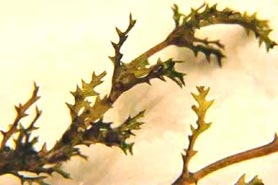Spiny naiad
(Najas marina)
Spiny naiad is a submerged aquatic plant that typically grows in lakes, ponds, reservoirs or slow-moving rivers and streams. Although native to some regions of the U.S., it is not a native aquatic plant in Wisconsin and may threaten water bodies.
Other names for this plant include:
- Common names: holly-leaved naiad, spiny water-nymph, spiny-leaf naiad, alkaline water-nymph, a holly-leaved water nymph, large nails, sawtooth, marine naiad, a seawater nymph.
- Scientific names: Najas gracilis, Najas major, Najas marina var. recurvata, Najas major var. angustifolia
Classification in Wisconsin: Restricted
- Ecological Threat
-
- Spiny naiad can form dense mats of submerged vegetation that can choke out other aquatic plant species in suitable habitats. In high densities, it can be a nuisance for boaters and anglers.
- Spiny naiad is readily eaten by waterfowl, and the plant seeds have been shown to germinate after digestion. This means plants could easily be spread by waterfowl.
- Seeds are considered long-lived in the seed bank, meaning short times of drawdown or low water are unlikely to eradicate this plant effectively.
- Identification
-
Leaves: Opposite or in whorls of three on the stem, 0.5 to 4.0 cm long and 0.4-4.5 mm wide. Leaves have 8-13 triangular teeth along the leaf margins and prickles on the underside midrib.
Flowers: Flowers are submerged and inconspicuous. They are water-pollinated and typically solitary in the leaf axils. Flowering occurs from late summer into autumn.
Fruits & seeds: Large amounts of complex, oval, brown seeds are produced and then dispersed by water.
Stems: Brittle and branched towards the upward section of the plant. Internodes on the stem have conspicuous, brown, prickly teeth.
Similar species: Other native naiad species (N. flexilis, N. gracillima, N. guadalupensis) exist in Wisconsin but can be easily distinguished as they do not have the prickles or easily visible teeth that spiny naiad has. Another invasive naiad, Najas minor or brittle naiad, has visible teeth along the leaf edges but lacks the prickles at the internodes.
- Distribution
-
See the reported locations of spiny naiad in Wisconsin.
Do you know of additional populations? Please send us a report.
- Control
-
Mechanical: Mechanical harvesting or hand-pulling can reduce the population of a spiny naiad. Still, it can grow from stem fragments, so care must be taken to avoid fragmentation or collect all parts. Due to the robust spines of the plant, physical removal by hand can be difficult.
Chemical: A range of aquatic-approved herbicides are available and be effective in controlling spiny naiad. Marine applications of herbicide will require a permit.
- Resources
- Sources for content:
- DiTomaso, J.M., G.B. Kyser et al., Weed Control in Natural Areas in the Western United States. Weed Research and Information Center, University of California, 544pp.
- USGS NAS Factsheet: factsheet [exit DNR]


